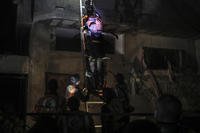As the Allies prepared to invade occupied Europe in 1942, a truly nutty idea swept through the British military hierarchy: build giant aircraft carriers made of ice.
The ships could be made cheaply, they figured. And, maybe, they could be constructed tough enough to withstand bullets and torpedoes.
With Churchill's blessing, Lord Louis Mountbatten, Chief of Combined Operations, began the task of developing "berg-ships" up to 4,000 feet long, 600 feet wide and 130 feet in depth.
His task seemed to get easier when, in early 1943, "two American professors discovered that a very tough material could be produced by adding a small amount of wood pulp to water before freezing. They called this material pykrete, in honour of (Mountbatten's scientific advisor) Geoffrey Pyke," Combinedrops.com says.
Lord Mountbatten had a block of pykrete prepared by a Canadian engineering company, and took this block to the Quebec Conference in the fall of 1943. As it appeared that "Habbakuk" would run into supply and technical problems, not to mention the high costs ($100 million for the first ship), it was Mountbattens aim to get the Americans to take over the project. It is reported that he fired a revolver at the pykrete block during a coffee break, and the bullet bounced off and struck one of the senior officers who were present - thankfully without serious injury!
Defense Tech Dad Tom Shachtman wrote about this folly in Laboratory Warriors : How Allied Science and Technology Tipped the Balance in World War II (out now in paperback). Take it away, Pop:
To my mind, the major interest of the story of this absurd enterprise is how far it went before the bubble was burst. This was a loony idea all along, and its premise was easily refuted by science and even easier by mathematics -- you just had to compute how much of the stuff would be needed to make a floating airfield, plug in a few figures about the output of wood from Canadian forests, and realize that it would take the entire country's forests to make one field.
But because the idea had powerful patrons, Churchill and Mountbatten, who were not scientists but politicians whose authority could direct the spending of millions of taxpayer dollars, millions of dollars were spent on it. It reminds us that Star Wars is not the only science-fiction fantasy to enchant the mind of a leader of the Western world.
(via Boing Boing)
THERE'S MORE: Defense Tech buddy Wyatt Earp points us to great pictures and diagrams of the berg-ships here and to a longer essay on the subject here.
AND MORE: Another Defense Tech pal says Mountbatten's effort wasn't "really the folly that it seems."
The coast guard long ago gave up trying to destroy icebergs and they are simple fresh water bergs, not pykrete. Given the other advances dreamt up by the British that made carrier-based jet aviation practical (and safer) like the angled flight deck and steam catapults it's not necessarily something to be dismissed out of hand. RULCCs (REALLY Ultra Large Crude Carriers) made of ice just might turn out to be structurally stronger and more damage resistant than the current crop of aging ULCCs rusting their way along the seaways today. Toss in built-in obsolescence and easy recycling...








